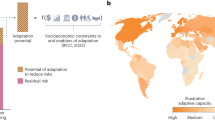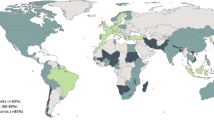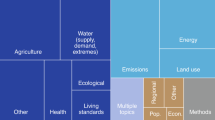Abstract
The impacts of climate change on human systems depend not only on the level of emissions but also on how inherently vulnerable these systems are to the changing climate. The large uncertainties over future development and structure of societies and economies mean that the assessment of climate change effects is complex. One way to deal with this complexity is by using scenario analysis that takes account of these socio-economic differences. The challenge is to identify the dimensions along which societies and economies evolve over time in such a way as to cover sufficiently different vulnerability patterns. This conceptual effort is critical for the development of informative scenarios. Here, we identify three dimensions that take into account the most relevant factors that define the vulnerability of human systems to climate change and their ability to adapt to it.
This is a preview of subscription content, access via your institution
Access options
Subscribe to this journal
Receive 12 print issues and online access
$209.00 per year
only $17.42 per issue
Buy this article
- Purchase on Springer Link
- Instant access to full article PDF
Prices may be subject to local taxes which are calculated during checkout

Similar content being viewed by others
References
Schneider, S. What is 'dangerous' climate change? Nature 411, 17–19 (2001).
Schwartz, P. The Art of the Long View: Planning for the Future in an Uncertain World (Wiley, 1998). The rationale behind the use of long-term scenarios for robust decision-making.
Millennium Ecosystem Assessment Ecosystems and Human Well-being Vol. 5 (Island Press, 2005).
International Energy Agency World Energy Outlook (OECD/IEA, 2009).
Nakicenovic, N. & Swart, R. (eds) IPCC Special Report on Emissions Scenarios (Cambridge Univ. Press, 2000).
Moss, R. H. et al. The next generation of scenarios for climate change research and assessment. Nature 463, 747–756 (2010). An up-to-date review of the history of climate-related scenarios and a presentation of the scenario process behind the creation of representative concentration pathways (RCPs), which will be used for the next IPCC assessment.
Kriegler, E. et al. Socio-economic Scenario Development for Climate Change Analysis CIRED Working Paper (CIRED, 2010). A proposed framework for the new generation of socio-economic scenarios, consistent with the RCPs.
van Vuuren, D. P. et al. Developing New Scenarios as a Thread for Future Climate Research IPCC Working Paper (IPCC, 2010). A proposed framework for the new generation of socio-economic scenarios, consistent with the RCPs.
Bouwman, A. F., Kram, T. & Goldewijk, K. K. Integrated Modelling of Global Environmental Change: An Overview of Image 2.4. (Netherlands Environmental Assessment Agency, 2006).
Edmonds, J. A., Clarke, J., Dooley, J., Kim, S. H. & Smith, S. J. Modeling greenhouse gas energy technology responses to climate change. Energy 29, 1529–1536 (2004).
Wise, M. et al. Implications of limiting CO2 concentrations for land use and energy. Science 324, 1183–1186 (2009).
Manne, A. S. & Richels, R. G. in Energy and Environment (eds Loulou, R., Waaub, J. & Zaccour, G.) 175–189 (Springer, 2005).
Fujino, J., Nair, R., Kainuma, M., Masui, T. & Matsuoka, Y. Multi-gas mitigation analysis on stabilization scenarios using AIM global model. Energy J. (Multi-Greenhouse Gas Mitigation and Climate Policy special issue 3), 343–354 (2006).
Weyant, J. P., De la Chesnaye, F. C. & Blanford, G. Overview of EMF-21: Multigas mitigation and climate change. Energy J. 22 (Multi-Greenhouse Gas Mitigation and Climate Policy special issue 3), 1–32 (2006).
Parry, M. L., Canziani, O. F., Palutikof, J. P., van der Linden, P. J. & Hanson, C. E. (eds) IPCC Climate Change 2007: Impacts, Adaptation and Vulnerability (Cambridge Univ. Press, 2007).
Lobell, D. B. et al. Prioritizing climate change adaptation needs for food security in 2030. Science 319, 607–610 (2008).
Allison, E. H. et al. Vulnerability of national economies to the impacts of climate change on fisheries. Fish Fisheries 10, 173–196 (2009).
Conway, D., Allison, E., Felstead, R. & Goulden, M. Rainfall variability in East Africa: implications for natural resources management and livelihoods. Phil. Trans. R. Soc. A 363, 49–54 (2005).
Patz, J. A., Campbell-Lendrum, D., Holloway, T. & Foley, J. A. Impact of regional climate change on human health. Nature 438, 310–317 (2005).
Ebi, K. L. & Semenza, J. C. Community-based adaptation to the health impacts of climate change. Am. J. Prevent. Med. 35, 501–507 (2008).
Costello, A. et al. Managing the health effects of climate change. Lancet 373, 1693–1733 (2009).
Revi, A. Climate change risk: an adaptation and mitigation agenda for Indian cities. Environ. Urban. 20, 207–229 (2008).
O'Brien, K. L. & Leichenko, R. M. Double exposure: assessing the impacts of climate change within the context of economic globalization. Glob. Environ. Change 10, 221–232 (2000). A presentation of the importance of interactions between multiple vulnerabilities, and especially those linked to globalization and climate change.
Gregory, P. J., Ingram, J. S. I. & Brklacich, M. Climate change and food security. Phil. Trans. R. Soc. B 360, 2139 (2005).
Helmer, M. & Hilhorst, D. Natural disasters and climate change. Disasters 30, 1–4 (2006).
Van Aalst, M. K. The impacts of climate change on the risk of natural disasters. Disasters 30, 5–18 (2006).
Pelling, M. Natural Disasters and Development in a Globalizing World (Routledge, 2003).
Rosenzweig, C., Solecki, W., Hammer, S. A. & Mehrotra, S. Cities lead the way in climate change action. Nature 467, 909–911 (2010).
Hallegatte, S. & Corfee-Morlot, J. Understanding climate change impacts, vulnerability and adaptation at city scale: an introduction. Clim. Change 104, 1–12 (2010).
Hardoy, J. & Pandiella, G. Urban poverty and vulnerability to climate change in Latin America. Environ. Urban. 21, 203–224 (2009).
Hoegh-Guldberg, O. et al. Coral reefs under rapid climate change and ocean acidification. Science 318, 1737–1742 (2007).
Yohe, G. & Tol, R. S. J. Indicators for social and economic coping capacity: moving toward a working definition of adaptive capacity. Glob. Environ. Change 12, 25–40 (2002).
Bennett, E. M. & Balvanera, P. The future of production systems in a globalized world. Front. Ecol. Environ. 5, 191–198 (2007).
Young, O. R. et al. The globalization of socio-ecological systems: an agenda for scientific research. Glob. Environ. Change 16, 304–316 (2006).
Groves, D. & Lempert, R. A new analytic method for finding policy-relevant scenarios. Global Environ. Change 17, 73–85 (2007).
Chen, R. S. & Kates, R. W. World food security: prospects and trends. Food Policy 19, 192–208 (1994).
Smit, B. & Wandel, J. Adaptation, adaptive capacity and vulnerability. Glob. Environ. Change 16, 282–292 (2006).
Dasgupta, S., Laplante, B., Wang, H. & Wheeler, D. Confronting the environmental Kuznets curve. J. Econ. Persp. 16, 147–168 (2002).
Noble, D. et al. in Ecosystems and Human Well-Being: Policy Responses, Volume 3 (eds Chopra, K., Leemans, R., Kumar, P. & Simons, H.) Ch. 13, 373–400 (Island Press, 2005); available at http://www.millenniumassessment.org/en/Responses.html.
Arnell, N. Climate change and global water resources: SRES emissions and socio-economic scenarios. Glob. Environ. Change 14, 31–52 (2004).
van Vuuren, D. P., Smith, S. J. & Riahi, K. Downscaling socioeconomic and emissions scenarios for global environmental change research: a review. Wiley Interdiscip. Rev. Clim. Change 1, 393–404 (2010).
Acknowledgements
We thank P. Dumas, C. Guivarch, B. O'Neill, P. Quirion, P. Roudier, J. Rozenberg and H. Waisman for their comments on a previous version of this paper. We also thank the AUGUR project, funded by the European Union 7th Research Framework, for their financial support.
Author information
Authors and Affiliations
Corresponding author
Ethics declarations
Competing interests
The authors declare no competing financial interests.
Rights and permissions
About this article
Cite this article
Hallegatte, S., Przyluski, V. & Vogt-Schilb, A. Building world narratives for climate change impact, adaptation and vulnerability analyses. Nature Clim Change 1, 151–155 (2011). https://doi.org/10.1038/nclimate1135
Published:
Issue Date:
DOI: https://doi.org/10.1038/nclimate1135
This article is cited by
-
Building social resilience in North Korea can mitigate the impacts of climate change on food security
Nature Food (2022)
-
Increased economic drought impacts in Europe with anthropogenic warming
Nature Climate Change (2021)
-
Focusing on differences across scenarios could lead to bad adaptation policy advice
Nature Climate Change (2021)
-
New methods for local vulnerability scenarios to heat stress to inform urban planning—case study City of Ludwigsburg/Germany
Climatic Change (2021)
-
A framework for identifying cross-border impacts of climate change on the energy sector
Environment Systems and Decisions (2019)



